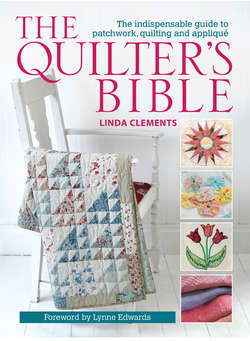Читать книгу The Quilter's Bible - Linda - Страница 13
На сайте Литреса книга снята с продажи.
ОглавлениеPressing Tools
• Press cloth (1) – This is a sheet, usually made from non-stick Teflon, which can be used to protect delicate fabrics and also to protect the iron from sticky fusible web residue. A sheet of greaseproof paper could also be used.
• Mini iron (2) – This is a heated tool with a small, pointed plate that makes precision pressing easier, especially for bias-strip appliqué. A small travel iron could be used instead, although its plate is bigger than that of a mini iron.
• Starch – Spray starch helps to firm up fabrics and makes cutting and sewing easier. Avoid over-spraying as this can distort the fabric as you press it.
• Steam iron – An iron is essential for all forms of patchwork, quilting and appliqué. In most cases it will be used dry but a steam function may be needed at times. See Pressing Fabrics.
• Ironing board – Use a standard ironing board with a tapered end for ironing creased fabrics and pressing work at all stages. A small or portable ironing board is useful for placing near the sewing machine for pressing patches as they are sewn. Boards are also available with a rotating surface.
Gizmos and Gadgets
There are some wonderful specialist products available for patchwork, appliqué and quilting. Many of these items are not essential but can make tasks easier and quicker. Whether you buy them or not depends on your budget and how much you think you will use them. A few are listed here.
• Magnets (1) – Magnets are useful for keeping errant needles and pins under control and having several means that you can keep pins on one, needles on another and safety pins on a third. Be sure to keep magnets away from computerized sewing machines.
• Seam ripper (2) – No one plans to unpick their work but mistakes happen and a seam ripper is useful for removing stitches without damaging fabric. Most sewing machines have one in the tool kit. They can also be used for holding down patchwork pieces as you sew them.
• Point turner (3) – This is a gadget with a sharp point that is used to make sure corners are pushed out properly when ‘bagging-out’ a quilt or project. A knitting needle could also be used.
• Measuring gauge (4) – A useful gadget marked with the commonly used seam allowances.
• Seam guide (5) – This little brass circle with a hole in the centre can be used to draw a 1⁄4in (6mm) seam around a shape, especially for templates.
• Quilting clips (6) – These are plastic rings that clip together and hold a rolled-up quilt together while you are quilting.
• Double-bladed stencil knife (7) – This is a useful gadget if you want to make your own quilting stencils. The double blade cuts a narrow channel.
• Elastic threader (8) – Available in different sizes, these can be used to thread elastic or for webbing when making bag handles.
• Bias bars (9) – These are also called bias press bars and are useful for bias-strip appliqué – see Using a Bias Bar for use.
• Bias maker – This is handy for making bias strips as the edges emerge from the gadget already turned under – see Using a Bias Maker for its use.
• Tweezers – Useful for fine positioning of embellishments, particularly beads.
• Tack gun – A handy gadget for those who hate tacking (basting) a quilt sandwich. It shoots little plastic tags through the quilt layers, securing them ready for quilting.
